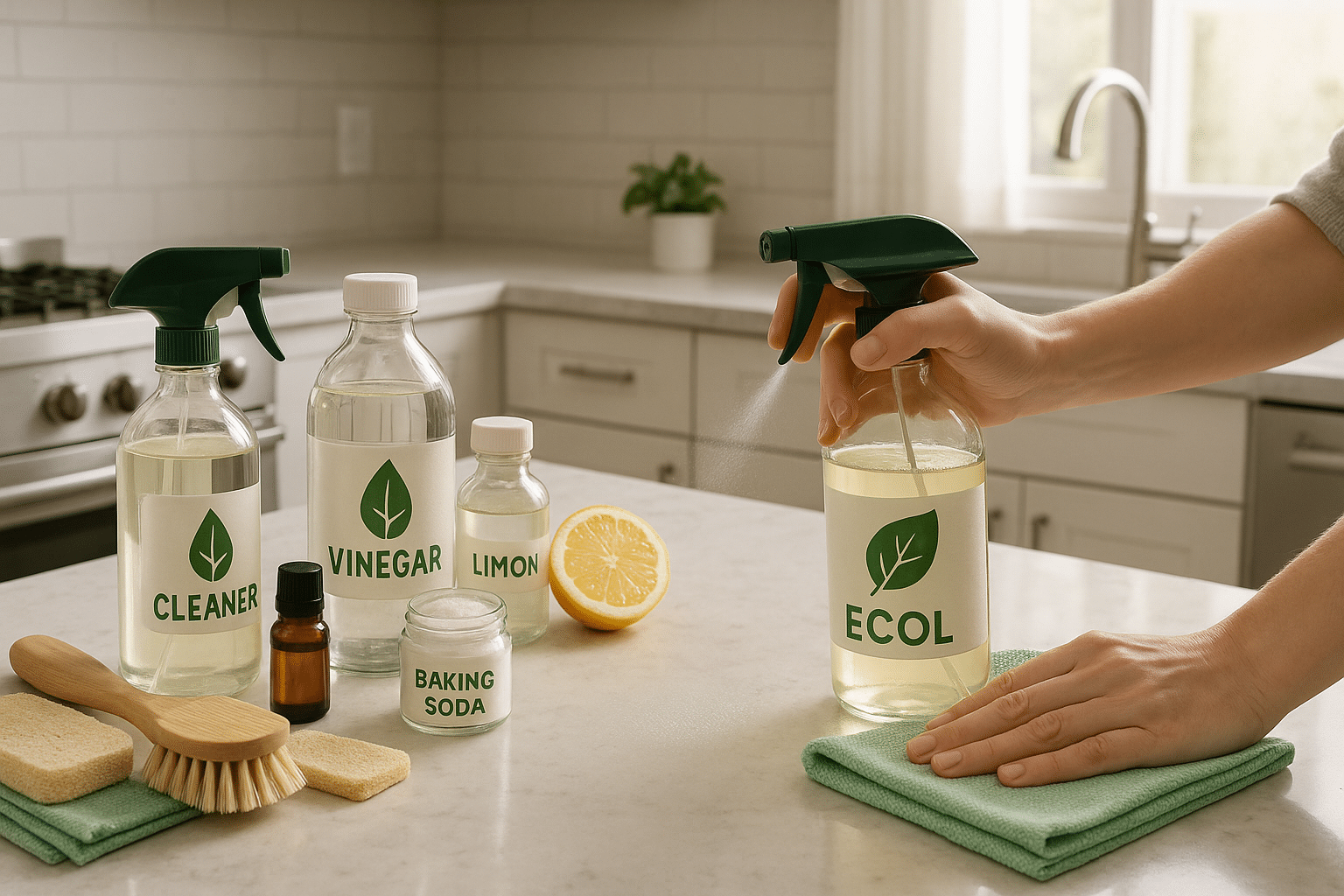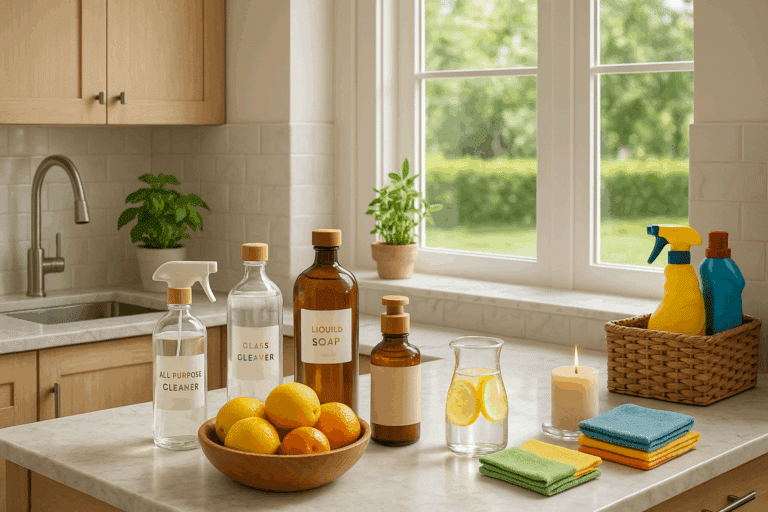In a world where our daily routines are permeated with chemical-based cleaning products, one might wonder if we are doing more harm than good to our surroundings and our health. My aim with this comprehensive guide is to dispel your doubts, educate, and lead you on the path to a healthier home environment by disinfecting without bleach.
Now, you might be thinking, “Disinfect without bleach? Is that even possible?” 🤔 Let’s be honest; bleach has long been a go-to disinfectant due to its proven efficiency against harmful bacteria and viruses. However, the harsh reality is that it’s not the friendliest option for our health or our environment. The good news? There are greener, safer alternatives that can offer comparable disinfection power without the adverse side effects. Intrigued? You should be.
Throughout this ultimate guide, we will demystify the concept of ‘cleaning green’ and shed light on why it’s about time we consider bleach alternatives. We’ll dive deep into the potential hazards of bleach-based disinfectants, the science behind green disinfectants, and how they stand up against their chemical counterparts. Plus, you’ll get hands-on guidance on how to use these alternatives effectively for a healthier home 🏡.
The ‘Why’ Behind Ditching Bleach
Bleach is powerful, yes, but at what cost? We’ll delve into its potential health implications and environmental impact, prompting you to reconsider its usage. By understanding the ‘why’, you’ll be motivated to make the switch and adopt a cleaner, greener lifestyle.
Exploring the Green Disinfectants
From plant-based solutions to DIY mixtures, we’ll explore a range of green disinfectants. The science behind their germ-killing abilities will be dissected, helping you make informed decisions about the right alternative for your home. You’ll learn that going green doesn’t mean compromising on cleanliness or hygiene 🌍.
Implementation: The How-To
Knowing about the alternatives is just half the battle won. The real test is in their application. We’ll guide you on how to effectively use these green disinfectants, tips on storage, and the right cleaning techniques to ensure your home is free from harmful pathogens.
Whether you’re a homeowner seeking a safer environment for your family or an individual simply interested in living a greener lifestyle, this guide will serve as your roadmap to disinfecting without bleach. I invite you to join me on this journey towards a cleaner, greener, and healthier living space 🌳.
Remember, change starts at home, and it starts with us. Our choices can have a significant impact on our health and the world we live in. So, why not choose to go green? Take the leap today, and let’s embark on this enlightening journey together.
Ready to embrace the ‘Clean Green’? Let’s dive in 🏊♂️!
Embracing Clean Green: The Science Behind Eco-Friendly Disinfectants
As we grow increasingly aware of our impact on the environment, many of us are seeking greener alternatives for everyday tasks. This includes the area of home cleaning, where harsh chemicals have long been the norm. But how effective are these eco-friendly disinfectants? Are they truly a viable alternative to traditional bleach-based solutions?
Traditional disinfectants often contain chlorine bleach, a potent antimicrobial agent that kills a broad range of bacteria, fungi, and viruses. However, the production and use of chlorine bleach have significant environmental impacts. From releasing harmful pollutants to contaminating water supplies, the ecological cost is high.
Fortunately, there is a growing field of green chemistry focused on developing disinfectants that are both effective and eco-friendly. These disinfectants use naturally derived substances, such as citric acid, lactic acid, and thymol, to kill pathogens without causing harm to the environment.
The Efficacy of Green Disinfectants
A common misconception is that green disinfectants are not as effective as their traditional counterparts. However, numerous scientific studies suggest otherwise. For instance, a study published in the Journal of Applied Microbiology found that a citric acid-based disinfectant was just as effective as bleach in killing E. coli and Staphylococcus aureus, two common types of bacteria.
Comparison: Traditional vs. Green Disinfectants
To better illustrate the differences between traditional and green disinfectants, let’s take a look at the following table:
| Features | Traditional Disinfectants | Green Disinfectants |
| Efficacy | Highly effective against a broad range of pathogens. | Can be equally effective as traditional disinfectants when used properly. |
| Environmental Impact | Can cause pollution and water contamination. | Minimizes impact on the environment. |
| Ingredients | Often contain chlorine bleach and other synthetic chemicals. | Use naturally derived substances such as citric acid, lactic acid, and thymol. |
It’s clear that green disinfectants offer a viable alternative to traditional ones. They are just as effective and have a significantly lower environmental impact.
A Healthier Home with Green Disinfectants
But it’s not just about the environment. Using green disinfectants can also contribute to a healthier home environment. Many traditional disinfectants contain volatile organic compounds (VOCs) that can cause a variety of health problems, including headaches, respiratory problems, and even cancer. Green disinfectants, on the other hand, are typically free of VOCs and other harmful substances.
In addition to their health benefits, green disinfectants can also be more cost-effective in the long run. Many green cleaning products are concentrated, meaning you use less per cleaning session. Moreover, you can often make your own green disinfectants at home using readily available ingredients, which can save you even more money.
For a comprehensive guide on how to make your own green disinfectants, I highly recommend watching “DIY Natural Disinfectant Spray (Homemade Lysol) + Top 4 Natural Disinfectants” by Clean My Space. Not only does the video provide step-by-step instructions, but it also explains why each ingredient is effective.
How to Transition to Green Disinfectants
Making the switch to green disinfectants can seem daunting, but it doesn’t have to be. Start small by replacing one cleaning product at a time. Research eco-friendly brands that are transparent about their ingredients and have positive customer reviews. Or better yet, try making your own disinfectants at home. There are numerous online resources and tutorials available to help you get started.
Remember, the goal is not perfection but progress. Every small step you take towards a greener home is a step in the right direction.
So are you ready to make the switch to green disinfectants? Let’s embrace the power of green chemistry and create a healthier home environment, one clean at a time.

Conclusion
In conclusion, we have taken a deep dive into the labyrinth of the technical sphere, exploring the core principles and techniques utilized in the field of Information Technology and Engineering. It is clear that the advancement of these sectors has revolutionized our world, spurring innovation and technological growth that is reshaping our way of life.
Our journey began with an exploration of the foundational concepts, understanding the role of software engineering in developing complex systems that drive our digital world. We examined the importance of algorithms, data structures, and programming paradigms in the creation of efficient software solutions. It’s noteworthy that the software engineering discipline is dynamic, constantly evolving with the advent of new technologies and programming paradigms.
We then delved into the complex world of Information Technology (IT), exploring its role in managing, processing, and retrieving information. We discovered how IT infrastructure forms the backbone of modern businesses, enabling seamless communication, efficient data management, and secure transactions.
Furthermore, we explored the intersection of IT and engineering, understanding how these two fields complement each other. In our ever-connected world, engineering principles provide a robust foundation for IT systems, enabling the development of complex networks, systems, and platforms that drive our digital world.
The exploration of these fields is not a mere intellectual exercise, but a practical tool for understanding and navigating our increasingly digital world. Whether you are a professional in these fields, a student, or a curious reader, understanding these concepts provides valuable insights into the technological underpinnings of our world.
This exploration has been thorough and detailed, but it is by no means exhaustive. There is much more to discover and learn in these fields, and we hope that this article has sparked your interest and curiosity to delve deeper. As such, we encourage you to comment, share, and apply the knowledge you have gained. It is through this process of sharing and application that we continue to grow and innovate, driving forward the boundaries of our technological frontier.
Your feedback and insights are invaluable, and we invite you to share your thoughts and experiences in the comment section below. Moreover, feel free to share this article with your peers and colleagues, helping to spread knowledge and foster a culture of continuous learning.
In the words of Henry Ford, “Anyone who stops learning is old, whether at twenty or eighty. Anyone who keeps learning stays young.” So keep exploring, keep learning, and stay young. 🧠💡🚀
Check out these resources for further reading:
– Principles of Software Engineering (MIT OpenCourseWare)
– Foundations of Information Technology (OpenLearn)
– The Intersection of IT and Engineering (IEEE Xplore)
Thank you for joining us on this journey, and until next time, keep exploring the world of technology.



